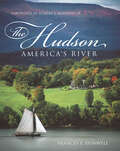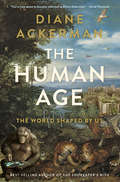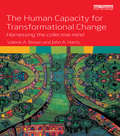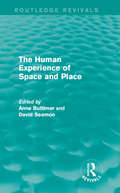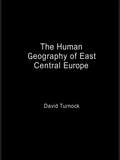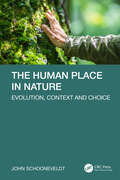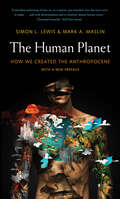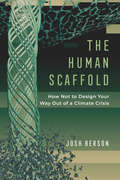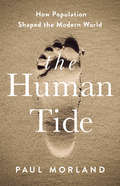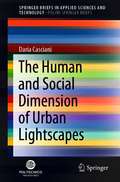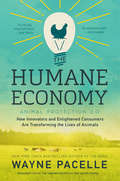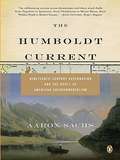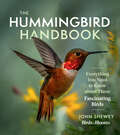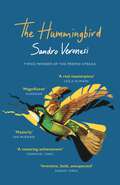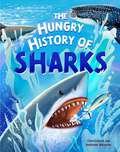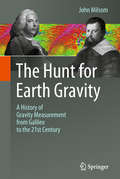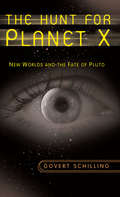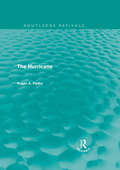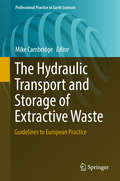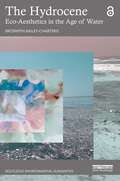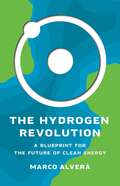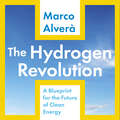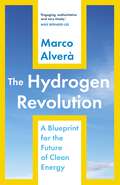- Table View
- List View
The Hudson: America's River
by Frances F. Dunwell&“A commanding and inspiring biography of a river that gave rise to an art movement, progressive social quests, [and] landmark environmental cases.&” —Booklist (starred review) Includes maps, photos, and illustrations Frances F. Dunwell presents a rich portrait of the Hudson and of the visionary people whose deep relationship with the river inspired changes in American history and culture. Lavishly illustrated with color plates of Hudson River School paintings, period engravings, and glass plate photography, The Hudson captures the spirit of the river through the eyes of its many admirers. It reveals the crucial role of the Hudson in the shaping of Manhattan, the rise of the Empire State, and the trajectory of world trade and global politics, as well as the river&’s influence on art and architecture, engineering, and conservation. &“A story of interaction between people and the environment and a story of continuing inspiration and renewal.&” —Library Journal
The Human Age: The World Shaped By Us
by Diane AckermanAs Diane Ackerman writes in her brilliant new book, The Human Age, "our relationship with nature has changed...radically, irreversibly, but by no means all for the bad. Our new epoch is laced with invention. Our mistakes are legion, but our talent is immeasurable." Ackerman is justly celebrated for her unique insight into the natural world and our place in it. In this landmark book, she confronts the unprecedented reality that one prodigiously intelligent and meddlesome creature, Homo sapiens, is now the dominant force shaping the future of planet Earth. Humans have "subdued 75 percent of the land surface, concocted a wizardry of industrial and medical marvels, strung lights all across the darkness." We tinker with nature at every opportunity; we garden the planet with our preferred species of plants and animals, many of them invasive; and we have even altered the climate, threatening our own extinction. Yet we reckon with our own destructive capabilities in extraordinary acts of hope-filled creativity: we collect the DNA of vanishing species in a "frozen ark," equip orangutans with iPads, and create wearable technologies and synthetic species that might one day outsmart us. With her distinctive gift for making scientific discovery intelligible to the layperson, Ackerman takes us on an exhilarating journey through our new reality, introducing us to many of the people and ideas now creating--perhaps saving--our future and that of our fellow creatures. A beguiling, optimistic engagement with the changes affecting every part of our lives, The Human Age is a wise and beautiful book that will astound, delight, and inform intelligent life for a long time to come.
The Human Capacity for Transformational Change: Harnessing the collective mind
by Valerie A. Brown John A. HarrisPressures for transformational change have become a regular feature of most fields of human endeavour. Master-thinkers and visionaries alike have reframed existing divisions as connecting relationships, bringing together as dynamic systems the supposed opposites of parts and wholes, stability and change, individuals and society, and rational and creative thinking. This reframing of opposites as interconnected wholes has led to realisation of the power of a collective mind.This book offers ways and means of creating the synergies that are crucial in influencing a desired transformational change towards a just and sustainable future. It describes how and why our current decision-making on any complex issue is marked by clashes between the different interests involved. More optimistically, the book pursues a mode of thinking that brings together government, specialised and community interests at the local, regional and personal scales in a collective transformation process. Practical examples signal the emergence of a new knowledge tradition that promises to be as powerful as the scientific enlightenment. Written in accessible language, this book will be insightful reading for anyone struggling with transformational change, especially researchers, students and professionals in the fields of administration, governance, environmental management, international development, politics, public health, public law, sociology, and community development
The Human Experience of Space and Place (Routledge Revivals)
by David Seamon Anne ButtimerHumanistic geography is one of the major emerging themes which has recently dominated geographic writing. Anne Buttimer has been one of the leading figures in the rise of humanistic geography, and the research students she collected round her at Clark University in the 1970s constituted something of a ‘school’ of humanistic geographers. This school developed a significantly new style of geographical inquiry, giving special emphasis to people’s experience of place, space and environment and often using philosophical and subjective methodology. This collection of essays, first published in 1980, brings together this school and offers insight into philosophical and practical issues concerning the human experience of environments. An extensive range of topics are discussed, and the aim throughout is to weave analytical and critical thought into a more comprehensive understanding of lived experience. This book will be of interest to students of human geography.
The Human Geography of East Central Europe (Routledge Studies in Human Geography)
by David TurnockThe Human Geography of East Central Europe examines the geography of the transition economies that were not formerly part of the Soviet Union: Albania, Bosnia & Hercegovina, Bulgaria, Croatia, The Czech Republic, Hungary, Macedonia, Poland, Romania, Slovakia, Slovenia, Yugoslavia and East Germany. There is a thematic treatment beginning with the landscape and historical background, which moves on to the social and economic geography (industry, agriculture and infrastructure) and to issues concerning regional development and environmental protection.
The Human Impact of Climate Uncertainty: Weather Information, Economic Planning, and Business Management
by W. J. MaunderOriginally published in 1989, this book provides an overview of the economic dimensions of climate and human activities, and considers how the variable nature of the atmosphere must be accepted as an integral part of the management package. It discusses how climatic repercussions can hold major importance for international politics, particularly in the light of the impacts of climatic changes induced by greenhouse gases.
The Human Place in Nature: Evolution, Context and Choice
by John SchooneveldtThis book explores a new approach to understanding the evolution of mind and consciousness by examining the perceptual abilities of animals and the way they experience their world. It offers a science-based bottom-up approach to our own conscious worldview by seeing it through the eyes of others. Emphasis is on the role of context in evolution and the way animals internalize and engage with the contextual properties of their world that are meaningful for them. The core argument is that a context, which is subjective and comprised of the perceptual capacities, offers new insights into the evolution of mind. Rather than seeing biological evolution in terms of the emergence of mindless forms and cultural evolution as the emergence of disembodied minds, the book seeks to integrate these two perspectives through the rigorous mapping of contexts.Key Features Reveals an understanding of animal minds Formulates a hypothesis for the evolution of consciousness Includes a discussion of the origin of technological innovation Provides a rationale for the ecology of mind Proposes a theory of the evolution of language Outlines the science of experience and how it influences choice Explains the role of context and choice with respect especially to human ecology
The Human Planet: How We Created the Anthropocene
by Mark A. Maslin Simon L. LewisAn exploration of the Anthropocene and “a relentless reckoning of how we, as a species, got ourselves into the mess we’re in today” (The Wall Street Journal).Meteorites, mega-volcanoes, and plate tectonics—the old forces of nature—have transformed Earth for millions of years. They are now joined by a new geological force—humans. Our actions have driven Earth into a new geological epoch, the Anthropocene. For the first time in our home planet's 4.5-billion-year history a single species is increasingly dictating Earth’s future.To some the Anthropocene symbolizes a future of superlative control of our environment. To others it is the height of hubris, the illusion of our mastery over nature. Whatever your view, just below the surface of this odd-sounding scientific word—the Anthropocene—is a heady mix of science, philosophy, history, and politics linked to our deepest fears and utopian visions.Tracing our environmental impacts through time, scientists Simon Lewis and Mark Maslin reveal a new view of human history and a new outlook for the future of humanity in the unstable world we have created.
The Human Scaffold: How Not to Design Your Way Out of a Climate Crisis (Great Transformations #2)
by Josh BersonHumanity has precipitated a planetary crisis of resource consumption—a crisis of stuff. So ingrained is our stuff-centric view that we can barely imagine a way out beyond substituting a new portmanteau of material things for the one we have today.In The Human Scaffold, anthropologist Josh Berson offers a new theory of adaptation to environmental change. Drawing on niche construction, evolutionary game theory, and the enactive view of cognition, Berson considers cases in the archaeology of adaptation in which technology in the conventional sense was virtually absent. Far from representing anomalies, these cases exemplify an enduring feature of human behavior that has implications for our own fate.The time has come to ask what the environmental crisis demands of us not as consumers but as biological beings. The Human Scaffold offers a starting point.
The Human Sustainable City: Challenges and Perspectives from the Habitat Agenda
by Bruno Forte Maria Cerreta Pasquale De ToroThis title was first published in 2003. Seven years after Habitat II culminated with the Istanbul agreement on Sustainable Urban Development, this book brings together many of the world's leading experts from the fields of architecture, urban planning, economics, sociology, politics, environment and geography to assess the successes and failures in fulfilling the objectives decided upon at this historic meeting. Illustrated with a wide range of case studies, this volume is divided into three main sections; firstly examining the challenges, secondly, the approaches, and finally, the practices. The book represents a critical appraisal not only of the issues related to urban development but also of the modalities to face these issues from real examples, these in return can be used as starting points to construct new 'real utopias' or at least, to future 'best practices'.
The Human Tide: How Population Shaped the Modern World
by Paul MorlandA dazzling new history of the irrepressible demographic changes and mass migrations that have made and unmade nations, continents, and empiresThe rise and fall of the British Empire; the emergence of America as a superpower; the ebb and flow of global challenges from Nazi Germany, Imperial Japan, and Soviet Russia. These are the headlines of history, but they cannot be properly grasped without understanding the role that population has played.The Human Tide shows how periods of rapid population transition--a phenomenon that first emerged in the British Isles but gradually spread across the globe--shaped the course of world history. Demography--the study of population--is the key to unlocking an understanding of the world we live in and how we got here. Demographic changes explain why the Arab Spring came and went, how China rose so meteorically, and why Britain voted for Brexit and America for Donald Trump. Sweeping from Europe to the Americas, China, East Asia, the Middle East, and North Africa, The Human Tide is a panoramic view of the sheer power of numbers.
The Human and Social Dimension of Urban Lightscapes (SpringerBriefs in Applied Sciences and Technology)
by Daria CascianiThis book explores new criteria and characteristics for integrating human psychology in the design of modern urban lighting. It identifies a new area of lighting design research and practice that focuses on the nocturnal urban experience in terms of people’s emotional, cognitive and motivational perceptions to achieve more accessible, sociable and sustainable cities. In turn, the book compares new tools and research methodologies for tackling complex issues concerning the ties between lighting, people and the city. Moreover, it presents a series of case studies to provide an in-depth understanding of the influence of urban lighting in terms of luminous atmosphere perception, positive social affect, social enhancement, accessibility and hospitability. Lastly, the book proposes a multidisciplinary qualitative and quantitative methodology for assessing the spatial experience of outdoor lighting.
The Humane Economy: How Innovators and Enlightened Consumers Are Transforming the Lives of Animals
by Wayne PacelleA major new exploration of the economics of animal exploitation and a practical roadmap for how we can use the marketplace to promote the welfare of all living creatures, from the renowned animal-rights advocate Wayne Pacelle, President/CEO of the Humane Society of the United States and New York Times bestselling author of The Bond.In the mid-nineteenth century, New Bedford, Massachusetts was the whaling capital of the world. A half-gallon of sperm oil cost approximately $1,400 in today's dollars, and whale populations were hunted to near extinction for profit. But with the advent of fossil fuels, the whaling industry collapsed, and today, the area around New Bedford is instead known as one of the best places in the world for whale watching.This transformation is emblematic of a new sort of economic revolution, one that has the power to transform the future of animal welfare. In The Humane Economy, Wayne Pacelle, President/CEO of the Humane Society of the United States, explores how our everyday economic decisions impact the survival and wellbeing of animals, and how we can make choices that better support them. Though most of us have never harpooned a sea creature, clubbed a seal, or killed an animal for profit, we are all part of an interconnected web that has a tremendous impact on animal welfare, and the decisions we make--whether supporting local, not industrial, farming; adopting a rescue dog or a shelter animal instead of one from a "puppy mill"; avoiding products that compromise the habitat of wild species; or even seeing Cirque du Soleil instead of Ringling Brothers--do matter. The Humane Economy shows us how what we do everyday as consumers can benefit animals, the environment, and human society, and why these decisions can make economic sense as well.
The Humboldt Current
by Aaron SachsWhile everyone has heard of the 'Humboldt Current', few know anything of the man after whom it was named. Yet Alexander von Humboldt was a towering figure of his time - scientist, explorer, and polymath, imbued with Enlightenment ideas - and he left a profound impact on the intellectual life of 19th century America. Aaron Sachs' colourful intellectual history rescues Humboldt from obscurity, and reveals the impact of a single European on both American thought and the environmental movement. Aaron Sachs traces Humboldt's legacy by focusing not only on the man himself but on the lives of other remarkable individuals who took their lead from him - explorers of the American mid-West, alienated Romantics, seminal American writers and artists, who together laid the groundwork for the great ecological tradition in 19th century America.
The Hummingbird Handbook: Everything You Need to Know about These Fascinating Birds
by John SheweyEverything you need to know about these fascinating birds Hummingbirds inspire an unmistakable sense of devotion and awe among bird lovers. Gardeners, too, love the company of hummingbirds, not only for their beauty, but also for their role as pollinators. Brimming with astonishing facts, practical advice, and important ecological information, The Hummingbird Handbook is a must-have guide to attracting, understanding, and protecting hummingbirds. From advice on feeders to planting and landscaping techniques that will have your garden whirring with tiny wings, lifelong birder John Shewey provides all you need to know to entice these delightful creatures. An identification guide makes them easy to spot in the wild, with stunning photographs, details on plumage variations, and range maps showing habitats and migration patterns. Need more joy in your life? Let this guide and nature&’s aerial jewels help you create a lively haven.
The Hummingbird: ‘Magnificent’ (Guardian)
by Sandro VeronesiA BOOK OF THE YEAR FOR THE GUARDIAN: 'DEEPLY PLEASURABLE'A BOOK OF THE YEAR FOR THE SPECTATOR: 'WHAT A JOY''Magnificent' Guardian'A towering achivement' Financial Times'Inventive, bold, unexpected' Sunday Times'Everything that makes the novel worthwhile and engaging is here: warmth, wit, intelligence, love, death, high seriousness, low comedy, philosophy, subtle personal relationships and the complex interior life of human beings'Guardian'Not since William Boyd's Any Human Heart has a novel captured the feast and famine nature of a single life with such invention and tenderness'Financial Times'There is a pleasing sense of having grappled with the real stuff of life: loss, grief, love, desire, pain, uncertainty, confusion, joy, despair - all while having fun'The Sunday Times'Instantly immersive, playfully inventive, effortlessly wise'Observer'Masterly: a cabinet of curiosities and delights, packed with small wonders'Ian McEwan'A real masterpiece. A funny, touching, profound book that made me cry like a little girl on the last page'Leïla Slimani'A remarkable accomplishment, a true gift to the world'Michael Cunningham'Ardent, gripping, and inventive to the core'Jhumpa LahiriMarco Carrera is 'the hummingbird,' a man with the almost supernatural ability to stay still as the world around him continues to change.As he navigates the challenges of life - confronting the death of his sister and the absence of his brother; taking care of his parents as they approach the end of their lives; raising his granddaughter when her mother, Marco's own child, can no longer be there for her; coming to terms with his love for the enigmatic Luisa - Marco Carrera comes to represent the quiet heroism that pervades so much of our everyday existence.A thrilling novel about the need to look to the future with hope and live with intensity to the very end.THE NO. 1 INTERNATIONAL BESTSELLEROver 300,000 copies soldSoon to be a major motion pictureWinner of the Premio StregaWinner of the Prix du Livre EtrangerBook of the Year for the Corriere della Sera
The Hungry History of Sharks (History of... #1)
by Clive GiffordThink all sharks are man-eating terrors? Think again! There's so much more to these fascinating and frequently misunderstood animals. This book takes you through the hungry history of these incredible creatures.Sharks range in size from whale sharks longer than buses, to Panama catsharks and dwarf lantern sharks that could sit across the palm of your hand. Find out about baby sharks, prehistoric sharks, the largest known shark - the Megaladon, bull sharks, reef sharks and angel sharks, amongst others. Look inside at the parts of a shark, such as their very light skeleton, their razor-sharp teeth and their extra special electric sense that humans don't have. Learn about their clever hunting and feeding techniques.How do we know so much about sharks? Discover how scientists are using many different technologies to find, follow and examine sharks to learn more about them. More than one-third of all shark and ray species are in danger of extinction. Learn what people are doing to help these formidable creatures.The colourful and detailed illustrations from Andressa Meissner bring the sharks vividly to life. The consultant, Leonardo Guida, (PhD) is a shark scientist and shark conservation lead at the Australian Marine Conservation Society.
The Hunt for Earth Gravity: A History of Gravity Measurement from Galileo to the 21st Century
by John MilsomThe author of this history of mankind’s increasingly successful attempts to understand, to measure and to map the Earth’s gravity field (commonly known as ‘little g’ or just ‘g’) has been following in the footsteps of the pioneers, intermittently and with a variety of objectives, for more than fifty years. It is a story that begins with Galileo’s early experiments with pendulums and falling bodies, progresses through the conflicts between Hooke and Newton and culminates in the measurements that are now being made from aircraft and satellites. The spectacular increases in accuracy that have been achieved during this period provide the context, but the main focus is on the people, many of whom were notable eccentrics. Also covered are the reasons WHY these people thought their measurements would be useful, with emphasis in the later chapters on the place of ‘g’ in today’s applied geology, and on the ways in which it is providing new and spectacular visions of our planet. It is also, in part, a personal memoir that explores the parallels between the way fieldwork is being done now and the difficulties that accompanied its execution in the past. Selected topics in the mathematics of ‘g’ are discussed in a series of short Codas.
The Hunt for Planet X
by Govert SchillingEver since the serendipitous discovery of planet Uranus in 1871, astronomers have been hunting for new worlds in the outer regions of our solar system. This exciting and ongoing quest culminated recently in the discovery of hundreds of ice dwarfs in the Kuiper belt, robbed Pluto from its 'planet' status, and led to a better understanding of the origin of the solar system. This timely book reads like a scientific 'who done it', going from the heights of discovery to the depths of disappointment in the hunt for 'Planet X'. Based on many personal interviews with astronomers, the well-known science writer Govert Schilling introduces the heroes in the race to be the first in finding another world, bigger than Pluto.
The Hurricane (Routledge Revivals)
by Roger A PielkeFirst published in 1990, this book describes the nature of the hurricane, one of the world's most dangerous weather hazards. It examines the formation, development, movement, and impact of these tropical cyclones, and assess the ability of science to describe, forecast, and control them.
The Hydraulic Transport and Storage of Extractive Waste
by Mike CambridgeThis book offers the guidelines on long-term confinement of fine particulate waste products in a safe and environmentally acceptable location. It seeks to present the state of the art, drawing on combined experience from within the European Union (EU), on good international practice where relevant and on lessons learnt from recent untoward incidents. These guidelines have been developed in parallel with the development of the European Standard on Earthworks (prEN 16907) and the contents have been influenced by the well-publicised need for guidance to all stakeholders on both technical and regulatory aspects of the permitting, design and construction of extractive waste facilities in Europe. The Extractive Waste Directive (EWD) imposes a duty on all operators and regulators to ensure the competent design, operation and closure of such facilities. However, though some guidance has been published on a limited number of related technical elements, the relevance of these contributions has been diminished by the lack of an integrated approach. It is now evident to both regulatory bodies and operators alike that a unified and comprehensive document providing guidance to all stakeholders is required if the future of mining within the EU is to be assured and further untoward incidents avoided. These guidelines seek to address all technical stages of the development of a hydraulic fill project in the context of the EWD, with an emphasis on waste and facility characterisation and on the risk-based assessments which underwrite them. They are intended for use by all stakeholders involved in those European industries which involve the generation, transport and storage of fine particulate waste products requiring long-term confinement in a safe, stable and environmentally acceptable location.
The Hydrocene: Eco-Aesthetics in the Age of Water (ISSN)
by Bronwyn Bailey-CharterisThis book challenges conventional notions of the Anthropocene and champions the Hydrocene: the Age of Water. It presents the Hydrocene as a disruptive, conceptual epoch and curatorial theory, emphasising water's pivotal role in the climate crisis and contemporary art.The Hydrocene is a wet ontological shift in eco-aesthetics which redefines our approach to water, transcending anthropocentric, neo-colonial and environmentally destructive ways of relating to water. As the most fundamental of elements, water has become increasingly politicised, threatened and challenged by the climate crisis. In response, The Hydrocene articulates and embodies the distinctive ways contemporary artists relate and engage with water, offering valuable lessons towards climate action. Through five compelling case studies across swamp, river, ocean, fog and ice, this book binds feminist environmental humanities theories with the practices of eco-visionary artists. Focusing on Nordic and Oceanic water-based artworks, it demonstrates how art can disrupt established human–water dynamics. By engaging hydrofeminist, care-based and planetary thinking, The Hydrocene learns from the knowledge and agency of water itself within the tide of art going into the blue.The Hydrocene urgently highlights the transformative power of eco-visionary artists in reshaping human–water relations. At the confluence of contemporary art, curatorial theory, climate concerns and environmental humanities, this book is essential reading for researchers, curators, artists, students and those seeking to reconsider their connection with water and advocate for climate justice amid the ongoing natural-cultural water crisis.The Open Access version of this book, available at http://www.taylorfrancis.com, has been made available under a Creative Commons Attribution-Non Commercial-No Derivatives (CC-BY-NC-ND) 4.0 license.
The Hydrogen Revolution: A Blueprint for the Future of Clean Energy
by Marco AlveràAn energy expert shows why hydrogen can fight climate change and become the fuel of the future We&’re constantly told that our planet is in crisis; that to save it, we must stop traveling, stop eating meat, even stop having children. But in The Hydrogen Revolution, Marco Alverà argues that we don&’t need to upend our lives. We just need a new kind of fuel: hydrogen. From transportation and infrastructure to heating and electricity, hydrogen could eliminate fossil fuels, boost economic growth, and encourage global action on climate change. It could also solve the most bedeviling aspects of today&’s renewable energy—from transporting and storing wind and solar energy and their vulnerability to weather changes to the inefficiency and limited utility of heavy, short-lasting batteries. The Hydrogen Revolution isn&’t just a manifesto for a powerful new technology. It&’s a hopeful reminder that despite the gloomy headlines about the fate of our planet, there&’s still an opportunity to turn things around.
The Hydrogen Revolution: a blueprint for the future of clean energy
by Marco Alverà'Engaging, authoritative and very timely. Marco Alverà spells Hydrogen's critical role as an energy store in the clean power transition' - Mike Berners-Lee, author of THERE IS NO PLANET BPicture this: It's 2050. The looming shadow of climate change is finally receding. The planet's temperature is stabilising. Rainforests and coral reefs beginning to thrive once more. We are returning to equilibrium with nature. This isn't wishful thinking; it can be our reality. We just need to embrace hydrogen: the missing link.The beauty of hydrogen is its simplicity. It's simple to make, and simple to use. You are essentially bottling sunlight from renewable energy sources in the form of hydrogen, and using it to bring clean energy to every corner of the globe. The best part about hydrogen is that when you use it, the only by-product is water.As energy expert Marco Alverà explains, if we're going to heal the climate, we need to start thinking big. This book is the blueprint for how to get us there. Whether you are a policy maker, a business person, an activist, or simply curious, the message is this: there is hope, for us and our planet. Hydrogen can help save the world.(P) 2021 Hodder & Stoughton Limited
The Hydrogen Revolution: a blueprint for the future of clean energy
by Marco Alverà'Engaging, authoritative and very timely. Marco Alverà spells Hydrogen's critical role as an energy store in the clean power transition' - Mike Berners-Lee, author of THERE IS NO PLANET BPicture this: It's 2050. The looming shadow of climate change is finally receding. The planet's temperature is stabilising. Rainforests and coral reefs beginning to thrive once more. We are returning to equilibrium with nature. This isn't wishful thinking; it can be our reality. We just need to embrace hydrogen: the missing link.The beauty of hydrogen is its simplicity. It's simple to make, and simple to use. You are essentially bottling sunlight from renewable energy sources in the form of hydrogen, and using it to bring clean energy to every corner of the globe. The best part about hydrogen is that when you use it, the only by-product is water.As energy expert Marco Alverà explains, if we're going to heal the climate, we need to start thinking big. This book is the blueprint for how to get us there. Whether you are a policy maker, a business person, an activist, or simply curious, the message is this: there is hope, for us and our planet. Hydrogen can help save the world.
